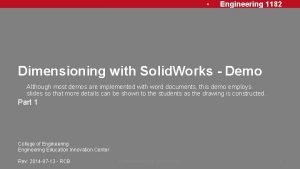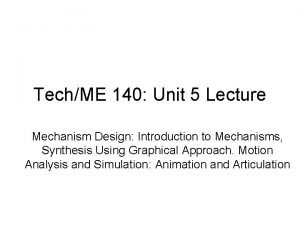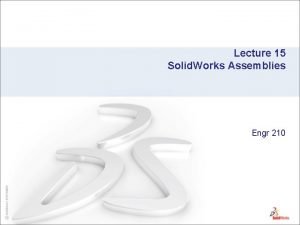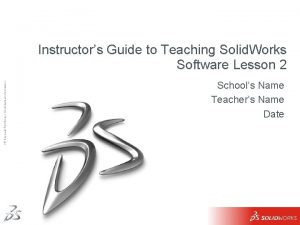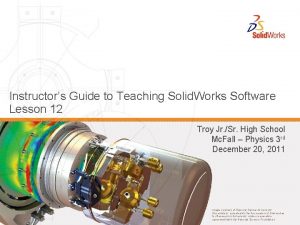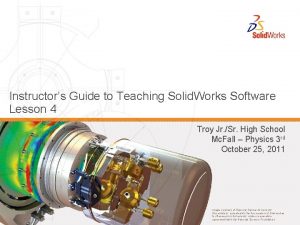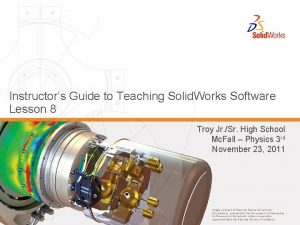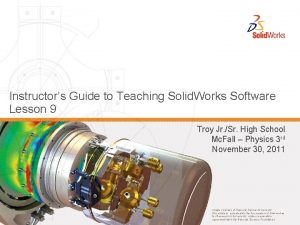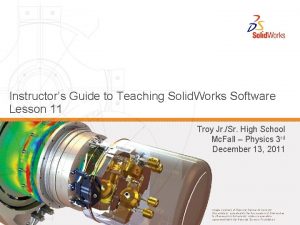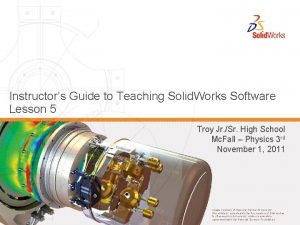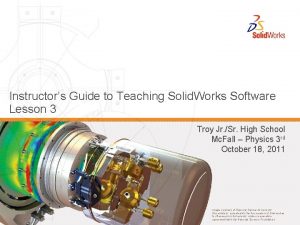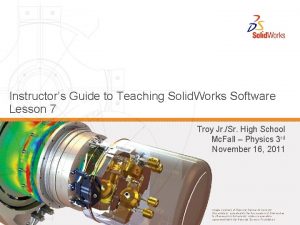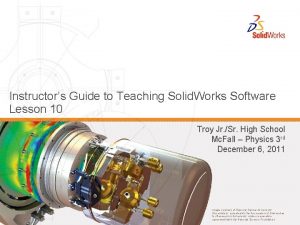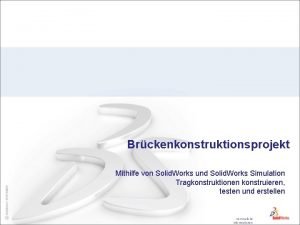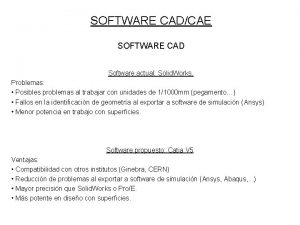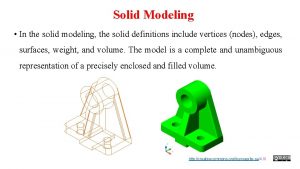Instructors Guide to Teaching Solid Works Software Lesson

















- Slides: 17

Instructor’s Guide to Teaching Solid. Works Software Lesson 1 Troy Jr. /Sr. High School Mc. Fall – Physics 3 rd October 3, 2011 Image courtesy of National Optical Astronomy Observatory, operated by the Association of Universities for Research in Astronomy, under cooperative agreement with the National Science Foundation.

Using the Interface The interface is how you interact with the computer in the following ways: § Use windows to view files. § Use the mouse to select buttons, menus, and model elements. § Run programs — like Solid. Works mechanical design software. § Find, open, and work with files. § Create, save, and copy files. 2

Microsoft® Windows® § Solid. Works runs on the Microsoft Windows graphical user interface. § Windows let you see the work of an application program. § Panels are sub sections of windows. § Illustration shows one window with two panels. 3

Using the Mouse § The mouse lets you move around the interface. § The cursor is the pointer that shows you where the mouse is on the screen. § Click the left mouse button to select commands, buttons, geometry, and other elements. § Double-click the left mouse button to quickly open a file or folder. § Click the right mouse button to access a shortcut menu of frequently used commands. 4

Running Programs § The quickest way to start a program is to double-click on a desktop shortcut. § Some programs may not have desktop shortcuts. § The Programs menu lists all of the application programs resident on the computer. 5

Exit a Program § Select or click File, Exit to end a program. § If the file has unsaved changes, you have the chance to save them before exiting. 6

Searching for a File or Folder § Click , Search, All files and folders to find files or folders. § Enter the search criteria in All or part of the file name: § If the search continues after you have found the file or folder, click. § Use * to perform wild card searches. 7

Wild Card Searches § Search for all files of a particular type by searching for the file type suffix. – Example: *. SLDPRT § Search for all files that begin the same. – Example: bearing* § Search for all files that have common letters in the file name. – Example *plate* 8

Opening a File § The quickest way to open a file is to double-click on it. § The File menu displays your most recently used files. 9

Saving and Copying Files § Saving a file preserves the changes that you have made to it. § Use File, Save As to copy a file. § File, Save As creates an exact duplicate of the file as it existed at the moment that you copied it. 10

Resizing Windows § Allows you to customize the appearance of your screen. § View multiple files at the same time. § Use window. to change the size of a window. to change the size of panels within a 11

Using the Solid. Works Interface § Solid. Works windows display graphic and nongraphic model data. § Toolbars display frequently used commands. 12

Left Side of Solid. Works Window § Feature. Manager® design tree § Property Manager § Configuration Manager 13

Right Side of Solid. Works Window The Task Pane § Solid. Works Resources § Design Library 14

Right Side of Solid. Works Window The Task Pane § Toolbox § File Explorer 15

Toolbars Buttons for frequently used commands. § You can select the toolbars to display. § Toolbars are displayed at the top and sides of the window. § You can also access the toolbars from the Command. Manager. 16

Getting Help To view comprehensive online help: § Click . § Select Help, Solid. Works Help. § Help displays in a separate window. 17
 Dale cone of experience
Dale cone of experience Safety at streetworks
Safety at streetworks Dimesioning
Dimesioning Solid works
Solid works Solid works
Solid works Solid works
Solid works Solid works simulation
Solid works simulation Crystalline vs amorphous
Crystalline vs amorphous An example of solid solution
An example of solid solution Covalent network solid vs molecular solid
Covalent network solid vs molecular solid Crystalline solid
Crystalline solid Crystal solid and amorphous solid
Crystal solid and amorphous solid Crystalline solid and amorphous solid
Crystalline solid and amorphous solid Anisotropy
Anisotropy When a solid completely penetrates another solid
When a solid completely penetrates another solid Interpenetration of surfaces
Interpenetration of surfaces Sifting separating mixtures
Sifting separating mixtures Phases of micro teaching
Phases of micro teaching


